Don’t Call Me María part 2
Indigenous women are fighting back to receive recognition of their textiles’ artistic value and a fair market share in the sales.
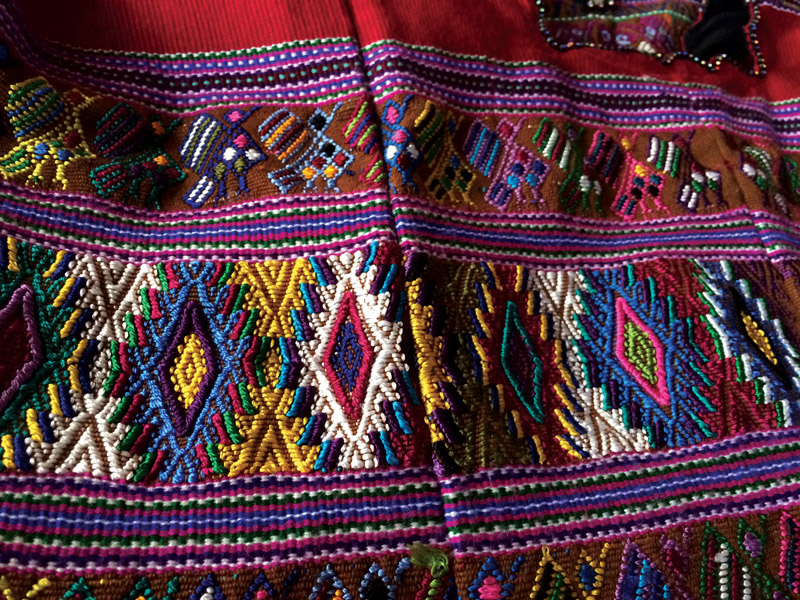
Detail of a huipil indigenous to San Juan Comalapa. The birds are protectors of the town. The rhomboid is called the Rupanplato, a dish for sacrifices to the deceased.
A cloth huipil, open like a book, lay on Natalia and Flavio Otzin’s wooden table, sunshine bouncing off its bright red, purple and blue designs. Otzin swept her hand across the shapes as she explained each one, reading the woven rows like lines from a page.
“And the little animals are the birds that take care of the town and they’re flying to the heavens. This is the rainbow in the sky. The red is the blood that our ancestors shed during the conquest. And here is a lion that takes care of the town; they are on the outskirts and take care of the town of Comalapa,” Otzin said.
Together the hand-woven images of animals, lion sentries of her town of San Juan Comalapa, pájaros, protective birds, and Rupan platos, plates offering sacrifices to the gods on behalf of the deceased, formed a running narrative indigenous to her village. The images were arranged in a sea of red representing the sangre (blood) spilled by the Mayans in armed conflicts. Every line of symbols was punctuated by rainbow paragraphs.
Our clothes are an intimate means to express an opinion, claim an allegiance and assert cultural identity. Each huipil is a soft tableau of narrative thread, historical reference and remembered zeitgeist accessible to all who choose to read the story.
Weaving in Guatemala is a matrilineal tradition that extends back to the beginning of the Mayan civilization and women are tied to past generations by the very threads they touch every day. When they teach their daughters, they link to their future.
“I learned with my mom, my mom wove, and in the same manner I too had to learn with my mom. I was 7,” Otzin said.
The stories the huipils tell are of a resilient people surviving famine, conquests, marginalization and discrimination. They recollect the history and tie the stories to the very bodies of the women who wear them. Today the loss of weaving and the turning away of young people from traditional dress is a threat to indigenous culture and identity.
The promise of better jobs and educational opportunities now spurs the young to abandon traditional dress, wear makeup and fit in. These factors threaten the huipil, the weaving traditions and the indigenous identity.
According to Silvia Otzin, a 34-year-old Maya now studying the Kaqchikel language and living in Comalapa with her three children and husband, the biggest threat to the customs is the loss of native languages and the way of dress.
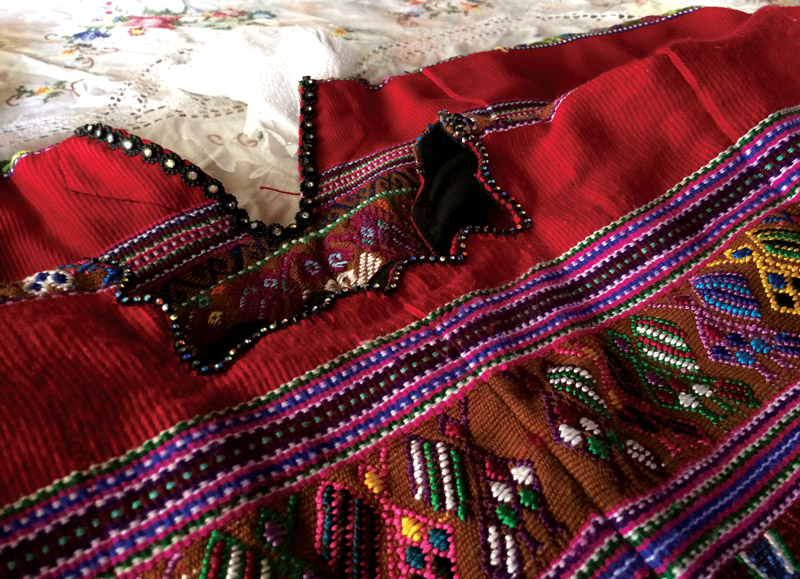
Huipil woven by Doña Natalia Otzin of Comalapa. Her design shows the red blood of the ancestors spilled in conquest. All of the figures are placed in a field of brown, the traditional color for her town.
“The biggest hopes for the indigenous is that they don’t lose their language [or] the way they dress, and in this manner there will be a connection between grandparents and the children,” Otzin said.
The threat to traditional dress comes in many forms. Today, young girls are encouraged to attend school, as in Natalia’s family, leaving little time to learn weaving. In Natalia’s case she couldn’t go to school because she had too many siblings to care for.
“I had too many siblings and I had to take care of them and learn how to weave and help mom. Mirian [my daughter] began school at age 7. I first went to school when I was 12, I went for two years, only two years,” Otzin said.
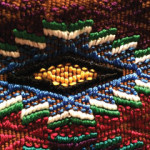
Detail of the Rupanplato, a rhomboid-shaped symbol representing
the plates of flowers offered as sacrifices to the Maya descendants.
Another factor is the loosening of machismo with fathers who want equal opportunities for their girls. Mirian Otzoy, the 42-year-old daughter of Doña Natalia and Don Flavio Otzin, said both parents were in favor of educating their two girls. Her mother wanted it because she herself did not receive an education. Her father, out of love for his daughter.
Many in their community were openly critical.
“My dad was always there for me, always helping me. I also remember that during elementary school there were people that would say, ‘Why are you going to let her study, she is a girl, it is not worth it.’ But finally, he said, ‘Leave me, I want to do it, and I know she will not let me down, so I will support her,’” Otzoy said.
Otzoy did learn to weave, taught by her mother Natalya after age 9, but she also completed her studies and received a degree in accounting.
Another threat to the sanctity and cohesion of the Mayan culture is the appropriation of artisan designs by national and multinational companies. But indigenous women are fighting back to receive recognition of their artistic value and a fair market share in the sales.
In the summer of 2016, the community development group the Asociación Femenina para el Desarrollo de Sacatepéquez (AFEDES), with the support of a membership numbered at 1,500 strong, petitioned the Constitutional Court of Guatemala to abridge copyright laws to include indigenous designs.
Angelina Aspuac, a 40-year-old mother of three, law student, weaver and daughter of farmers, acting as a spokesperson for the group, says the practice of using huipils in manufacturing of handbags, belts and jewelry frequently does not compensate the artisan commensurate with the amount of time invested in the work.
The huipils are not always treated with the sanctity they deserve, which AFEDES says is equal to a spiritual representation of the cosmovision of Mayan beliefs.
“Today we demand that the state give intellectual property rights [protection] over our textiles and Mayan traditional dress,” Aspuac said.
The lack of protection allows national and multinational companies to own and profit from Mayan ancient designs, cutting up a sacred text into consumer bites without fair compensation returning to the weavers.
The controversy seems to center on which party has fundamental ownership and control of the textiles. As an attractive consumer product there are many who seek ownership in order to profit from the textiles. A fuzzy boundary exists between protection and exploitation and depends on which authority is speaking.
According to Alida Boer, the founder of MARIAS (formerly MARIAS Bags), a high-fashion model and former Miss Guatemala, her company is a protector of the artistry and a purveyor of Guatemalan culture onto a world screen. She doesn’t believe that theft of designs is real and thinks selling bags with fixed artistic textiles is a way to dispense knowledge and appreciation of the culture.
“This is the way to promote our culture, because honestly, I don’t think anyone is stealing anyone’s designs. I think those belong to our country in general,” said Boer.
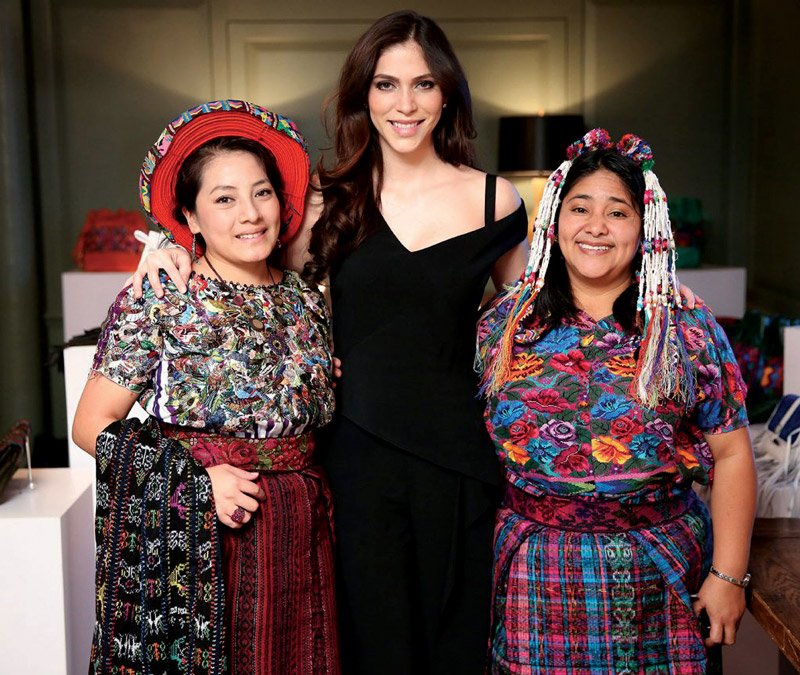
Alida Boer, founder of MARIAS, stands flanked by indigenous women
who help her plan the designs for her handbag, scarf and belt collections.
When Boer went to London in 2007 on a Miss World trip she wore a huipil gifted to her by a community member.
“They gave me a huipil. When I took it to London every single girl was interested in it. You can see when the tourists come to Guatemala they go crazy over the textiles. We in Guatemala have so many beautiful things to show the world,” Boer said.
But the indigenous feel differently. They see the designs as their own history, a tableau of history and mindfulness relating to a unique culture dating back before the Spanish conquerors.
“Our ancestral knowledge and our weavings are knit together, we want to share it with the world, but in a fair manner, with rules that are clear. That is what we indigenous women are proposing,” Aspuac said.
Boer’s products range in price from $125 to $1,300 and are arranged on their website according to departments and regions of Guatemala. The website devotes a lot of copy to connecting the stories of indigenous history to the end products, including an ethno-history of the designs and their connectivity with the lexicon of the region of origin.
For instance, products inspired by the textiles of Nahualá are introduced with the information that the zig-zags represent a snake or Kumat’z in the Quiche language. Such information supports Boer’s argument that her aim is to support the history of the textiles and the artisans.
“We want to showcase them around the world. We don’t treat the textiles as a souvenir. We use the term ‘artisanal couture.’ Guatemala is the biggest country with a textile heritage. Textiles empower women through fashion and design,” Boer said.
In this way the indigenous origins are honored, the stories preserved. MARIAS has 25 employees in her factory and works with over 500 people in the collectives where she purchases her textiles. She was unable to give information as to the wages of the weavers who work with her buyers.
Others see MARIAS as an example of the appropriation that is offensive to the indigenous. Just the name “María” is an epithet for indigenous women, according to Aspuac. It can be used in the street as an ethnic slur to reduce all indigenous women to the status of a servant or domestic maid.
“María” is also offensive because it is a colonial name used by the Spanish and reminds the indigenous of when they were forced to abandon their religion, customs and ethnic names. To refer to an indigenous woman as a “María” is to erase her heritage and reduce her to a servile status.
“I think it is important to understand that racism and discrimination is very prevalent here in Guatemala. For Ladino people who are racist, we don’t have a face; they do not see us in our spirituality. That is why they call us ‘Marías,’ which is synonymous to making all of us servants. We can also be professionals, attorneys.
The point is that indigenous women are not seen as attorneys, architects and engineers but rather like servants, especially when we wear our attire in the capital, at the university, in schools in institutes, the treatment we get is different to the one given to the woman wearing pants, a skirt or dress, it is different.”
Boer defends her use of the name María saying that it is a beautiful name meant to include all women, both the women who make the bags and those who enjoy them. It is her middle name and the name of a co-founder of her company.
“I wanted a name that represents the woman as a whole. Not just the woman who makes the bag, but the woman who uses the bag. For me it’s a very important name even though people judge it critically. For me it’s a very important name. I’m Catholic so it’s a very important name,” Boer said.
When asked if the name could be associated with racism she responded with conviction:
“Racism is a concept. Would I have called it Alida María, would it have made a difference?”
REVUE article by Elizabeth Rose
Part 1 of this series appeared in Revue, June, 2017.
Next month, Don’t Call Me María, Part 3 will look at the non-profits that also use huipils in product design. Business owners and non-profit leaders will respond to the prospect of the passage of a copyright law protecting indigenous designs.
For more information visit Women’s Association for the Development of Sacatepéquez (AFEDES), a grassroots organization that began in 1985 and now boasts a membership of 1,500 women.
To read Don’t Call Me María Part I, Click HERE
To read Don’t Call Me María Part III, Click HERE
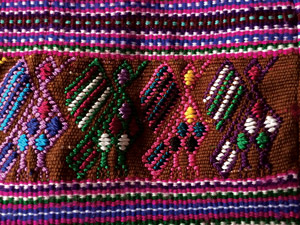
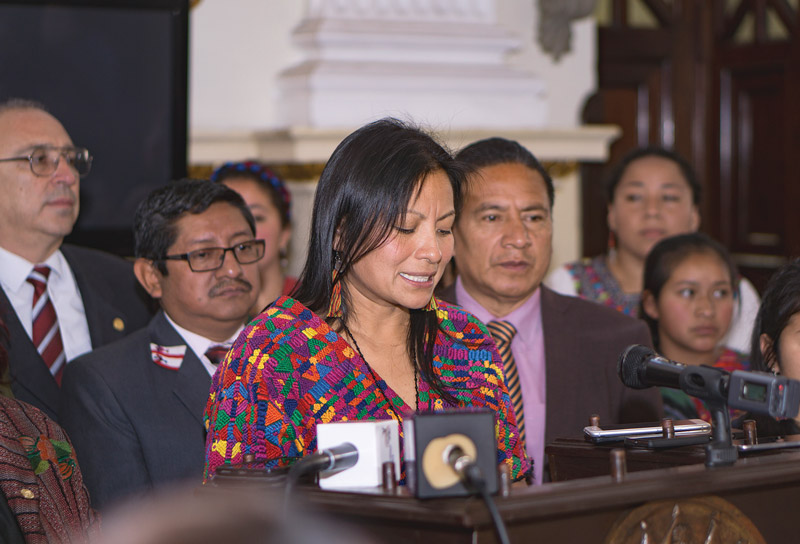
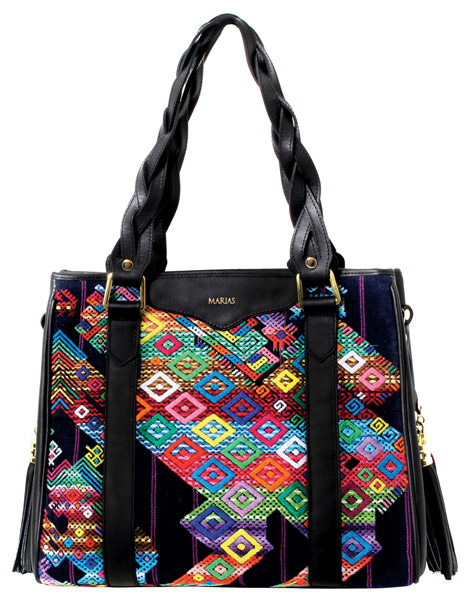
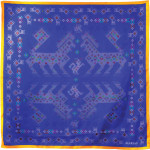

Pingback: Don’t Call Me María - Revue Magazine
Pingback: Don't Call Me María part 3 - Revue Magazine
Pingback: Weaving a narrative – Thousand Currents
This is strange because my grandmother’s name is Maria Rosa Caterina Disanto ok on my great grandfather’s passport his name was Angelo Disantis (Disanto) (cianciosi) he was a general for furci Italy he was italian he fought in world war 1 & world war 2 worked in a steel infirmary and he had control in many few states in America which said the states names on the passport which meant his respect brought power and he had power over authority so that meant he was a don…but to make things awesome on his passport it said he was guatemalteca!!! Shouldnt it be guatemalteco (masculine)anyways that meant that he was guatemalan!!! So the name Maria to be respected that was both his daughters names!!! But my only question is did he name both daughters Maria as an insult the mother could of named them her name was Lucia rocchio sbrocco she was from abruzzese Italy see Italy had an arranged marriage on both sides from my great grand father and my great grand mother they got married in Italy and Italy arranged the marriage!!!now so i don’t know if it was disrespect but someone who can identify an Italian/guatamalan descent with an Italian descent both makes a child named the children MARIA was it at all disrespectful for the children to be named MARIA? I mean MARIA is a popular name in Italy and my great grandfather was born in Italy but he had guatamalan descent i don’t know so let me know people!!!!